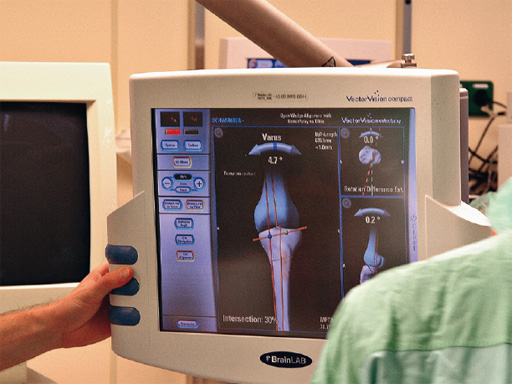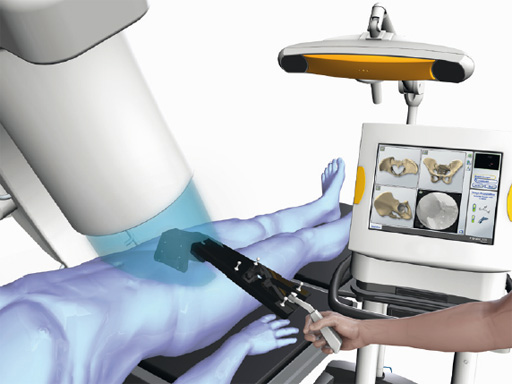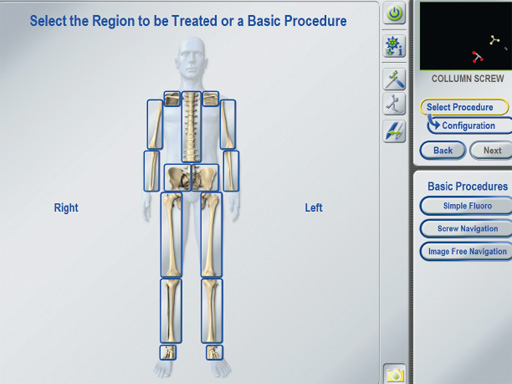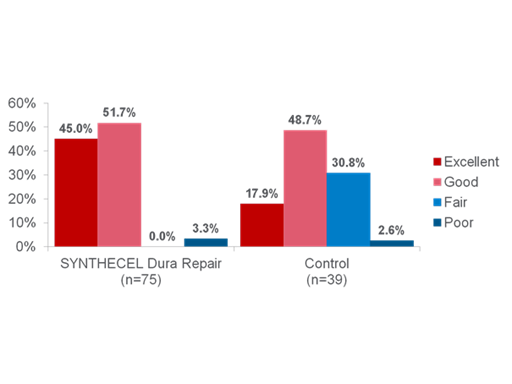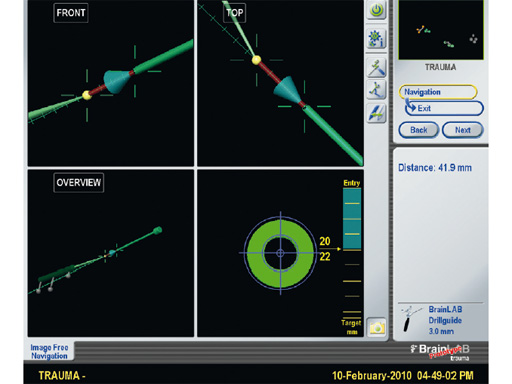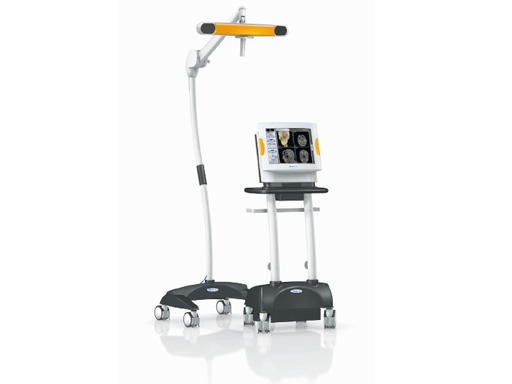
Trauma Navigation Module 3.0
Florian Gebhard
The trauma two-dimensional (2-D) navigation module was developed together with Brainlab to support the broad range of indications and to improve speed, first-pass accuracy, and radiation efficiency in trauma procedures. Trauma 3.0 offers dedicated workflows for navigated treatments in most regions of the body including inferior and superior extremities, the spine, and the pelvis, complemented by generic navigation workflows without localization presetting for regions. Those allow navigating in C-arm projections without prior region definition, just as specified by the surgeon.
All workflows support targeting of trajectories, eg, for drilling or for the placement of wires or screws. Where appropriate, the software supports specific planning or navigation tools to answer specific questions, eg, fragment alignment in long bone fractures. The software additionally offers for appropriate indications a virtual aiming device, which necessitates neither image intensifier images nor reference fixation to the bone.
Clinical benefits of the use of the trauma module can be summarized:
- First-pass targeting accuracy reduces iatrogenic trauma by trial and error approaches
- Improved fracture alignment and implant positioning reduces fracture malalignment
- Virtual image intensification, planning, and navigation reduces invasiveness of implant placement
- Virtual image intensification reduces radiation exposure
Fast C-arm image registration
Registration of C-arm images is a crucial step in the trauma navigation workflow. To face this, the new xSpot registers even tricky projections in specific indications easily and within seconds for reliable and accurate navigation image data.
The system offers:
- Wireless carbon registration device
- Autoclavable—no draping
- Works with almost all C-arms
- Fast, reliable, and reproducible result
One program for many different indications
Because there are as many different indications as injuries, the scope of trauma 3.0 navigation meets the challenges facing trauma surgeons in their daily practice. The optimized user interface gives intuitive access to most of the anatomy via the "bone man" surgical reference guide.
This allows for:
- Accurate, quick, and easy guidance in most regions of the body for many different tasks
- Specific workflows for specific tasks
- Generic approaches for universal tasks
- Based on AO techniques and workflows
Time-saving and innovative trauma navigation tools
Virtual tools on the screen add vital information during procedures and smart planning tools speed up intraoperative planning, such as
- Angulation template
- Automatic axis detection in long bones
- Cutout warning for femoral and humeral head
- Collision check for acetabular screws
Reduces invasiveness through new implant handling
The integration of dedicated implants into trauma navigation helps to extend the potential of many less-invasive implant lines by targeting entry points on the smallest access paths or placing interlocked plates while virtually checking implant and fragment positions. Among the integrated implants are Synthes locking compression and dynamic locking compression plates, as well as the LFN. (Regulatory approval for the respective handles pending at the time of print.)
Introduce trauma navigation to arthroscopic procedures
The new pinless and x-ray-free trauma navigation concept "image-free navigation" works without bone references and without x-ray imaging. This opens up arthroscopic procedures and articular lesions to treatment, even when accessibility is reduced. Pin placement or retrograde access to lesions can be fully supported by trauma navigation.
Navigation systems bring trauma navigation to the surgeons hands
The trauma 3.0 software runs on a Brainlab navigation system. This consists of a computer and monitor suitable for intraoperative use, a stereoscopic camera and navigated instruments for referencing and targeting.
System configurations range from small mobile trolleys, as shown in Fig 7, to fully integrated ceiling-mounted systems, adapted to specific needs of the surgeon. Different software applications (like the described trauma 3.0 software) may run on the system and cover—beneath trauma—eg, arthroplasty, spine, CMF, or neurosurgical navigation, depending on the individual system configuration.
Trauma-relevant applications enable the use of intraoperative imaging, eg, different C-arm types for 2-D navigation, and 3-D image intensification, or intraoperative CT for 3-D navigation, depending on configurations.
Hazards and labeling
Due to varying countries’ legal and regulatory approval requirements, consult the appropriate local product labeling for approved intended use of the products described on this website. All devices on this website are approved by the AO Technical Commission. For logistical reasons, these devices may not be available in all countries worldwide at the date of publication.
Legal restrictions
This work was produced by AO Foundation, Switzerland. All rights reserved by AO Foundation. This publication, including all parts thereof, is legally protected by copyright.
Any use, exploitation or commercialization outside the narrow limits set forth by copyright legislation and the restrictions on use laid out below, without the publisher‘s consent, is illegal and liable to prosecution. This applies in particular to photostat reproduction, copying, scanning or duplication of any kind, translation, preparation of microfilms, electronic data processing, and storage such as making this publication available on Intranet or Internet.
Some of the products, names, instruments, treatments, logos, designs, etc referred to in this publication are also protected by patents, trademarks or by other intellectual property protection laws (eg, “AO” and the AO logo are subject to trademark applications/registrations) even though specific reference to this fact is not always made in the text. Therefore, the appearance of a name, instrument, etc without designation as proprietary is not to be construed as a representation by the publisher that it is in the public domain.
Restrictions on use: The rightful owner of an authorized copy of this work may use it for educational and research purposes only. Single images or illustrations may be copied for research or educational purposes only. The images or illustrations may not be altered in any way and need to carry the following statement of origin “Copyright by AO Foundation, Switzerland”.
Check www.aofoundation.org/disclaimer for more information.
If you have any comments or questions on the articles or the new devices, please do not hesitate to contact us.
“approved by AO Technical Commission” and “approved by AO”
The brands and labels “approved by AO Technical Commission” and “approved by AO”, particularly "AO" and the AO logo, are AO Foundation's intellectual property and subject to trademark applications and registrations, respectively. The use of these brands and labels is regulated by licensing agreements between AO Foundation and the producers of innovation products obliged to use such labels to declare the products as AO Technical Commission or AO Foundation approved solutions. Any unauthorized or inadequate use of these trademarks may be subject to legal action.
AO ITC Innovations Magazine
Find all issues of the AO ITC Innovations Magazine for download here.
Innovation Awards
Recognizing outstanding achievements in development and fostering excellence in surgical innovation.


